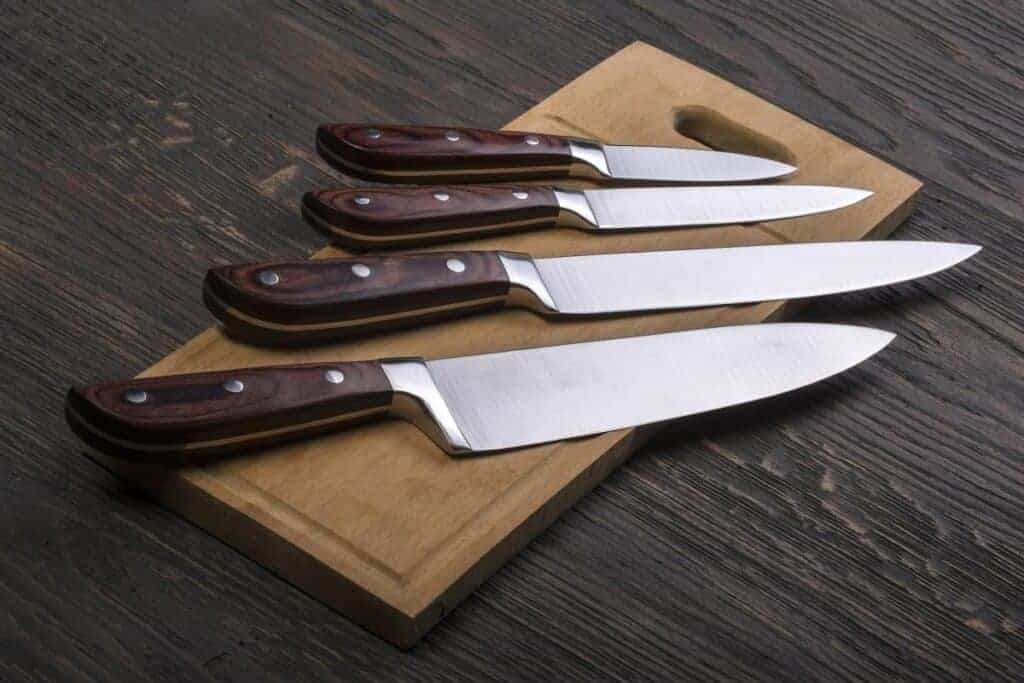This post contains affiliate links. As an Amazon Associate I earn from qualifying purchases
Table of Contents
White Steel vs Blue Steel Knives
Whether you want to become the next Masterchef or you simply enjoy cooking at home, owning a good set of knives is essential. A regular knife is made out of steel, which is a combination of carbon and iron. For stainless steel, chromium is added to this combination.
While iron is the major base, any good knife should feature somewhere between 0.5% and 1.8% carbon. The higher the percent, the better durability and the sharper edge you will get. Thus, we can say with confidence that a high-carbon, stainless-steel knife is a professional-grade item.
Considering this, you need to know the difference between white and blue steel high-carbon knives. While one has a better cutting edge, the other can endure years of heavy use. Let’s take a look at the difference between these two types of knives and see which one comes out on top in the battle of steel knives.
Should You Get a High-Carbon Steel Knife?
Before we discuss white steel vs. blue steel, we should consider whether high-carbon steel is actually worth investing in. As we have mentioned above, these knives greatly differ from regular iron/0.6% carbon knives. They differ in terms of edge retention, durability, and usability, as their price-quality ratio.
First and foremost, high-carbon steel is almost indestructible. Even if you tried to prepare your food on a stone surface, there shouldn’t be any issue with the knife’s cutting ability. This goes for metal, as well as all other surfaces that would usually damage surgical steel knives. This is partly due to the higher carbon content.
However, it is also due to the fact that there are chromium and tungsten in the build of the blade (blue high-carbon). Thus, you would have to put forth a lot of effort to actually damage it. While a knife of this type may be on the pricier side, just remember that it is a long-term investment.
The second important aspect is how well it holds its sharpness. We have performed multiple tests with both blue and white high-carbon knives. It is safe to say that both of these types can hold sharpness for weeks. This should not be a surprise, considering carbon is well-known for providing reliable cutting edges.
Again, the higher the carbon content, the better the knife. Also, resharpening it with a regular honing tool or a knife sharpener can be done within a minute.
Still, while a high-carbon steel knife is something we would recommend to any true enthusiast, there are a couple of concerns. First and foremost, you need to invest considerable effort into maintaining it to keep it shiny and rust-free.
Unlike some other materials, this one is not stain-resistant or rust-resistant. This means you need to apply specific dissolving agents in order to clean it. Some mild discoloration will not degrade its impact and cutting ability, but the aesthetics will not be as nice.
Talking about stains, any kind of colored fruit or vegetable with a strong acid level may leave marks on the knife. These would be items such as citrus, grapes, or tomatoes. Over time, the blade loses its original color, darkens, and eventually becomes completely black.
The Difference Between White and Blue Steel
After discussing the advantages and disadvantages of owning a high-carbon knife, it is now time to consider the different types. For the past few decades, there has been a huge debate on white steel vs blue steel knives. However, no article seems to come up with a final verdict.
The main difference between these two is the type of carbon that is mixed with iron. Fine carbon is used in making white steel knives. Hence, it is free from unnecessary compounds and contaminants from both carbon and iron.
These contaminants can reduce the sharpness of the cutting edge. It is important to note that white steel knives are hard to forge. This is why there are only a limited number of brands that deal with these. You can hone this knife to be as sharp as a razor, making it perfect for precise cutting and arranging sushi, sashimi, and other more delicate tasks.
Within this type, there are two different variations. White carbon #2 is more common among professional chefs given the fact that it is more reliable and easier to maneuver. On the other hand, white carbon #1 has better edge retention and is the sharpest knife on the market.
We have already mentioned that the main three elements of stainless steel are iron, carbon, and chromium. There needs to be at least 12% chromium in the blade to ensure that the steel is stain-resistant. Another element that is added to stainless steel is blue carbon. While white carbon knives come in two variations, this one comes in three. The main difference between them is that blue steel knives add tungsten to the iron and carbon. This contributes to the overall durability of the edge. It is not a secret that white carbon is sharper, but blue carbon works better if you are looking for reliable performance.
Blue carbon #1 has a much higher content of carbon than blue carbon #2. However, the latter is better for everyday use. The third variation is the so-called super-blue carbon steel, as it incorporates vanadium into the build. Wear-resistant and the most durable out of all the aforementioned knives, this one comes in at the highest price point.
Final Thoughts
In the end, choosing white steel vs blue steel knives all depends on your personal needs and budget. If you were to ask us, owning a couple of high-carbon knives is a good investment. Yes, these may not be as attractive or resistant to discoloration, but they are certainly worth the price.
We think that owning a white carbon steel #1 and a blue carbon steel #2 is the perfect combination. You will be getting the ability to fine cut with the first one, while the second can be used on an everyday basis for less delicate tasks.


